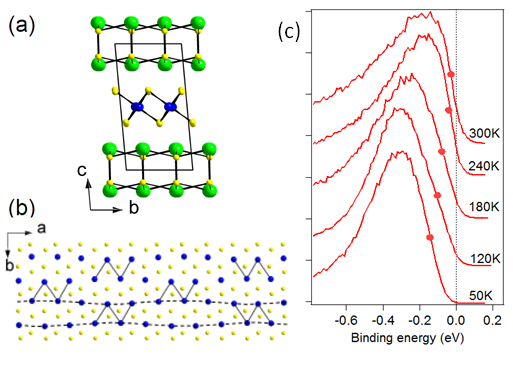Metal-insulator transitions are one of the most spectacular phenomena in condensed matter…
In many very different situations, we can observe variations of several orders of magnitude in the resistivity of a compound according to different parameters: temperature, doping, pressure, electric or magnetic fields. When this parameter is easy to control, by an electrical pulse, for example, these transitions could be interesting to exploit in certain applications (resistive switches). On the other hand, their origins can be very diverse and being able to identify them often leads to an intimate understanding of the nature of the material. For example, they may simply be due to a structural transition, or to complicated correlations between electrons, or even a mixture of both where interactions between electrons and lattice vibrations play an essential role.
Several French groups (LPS-Orsay, LSI-Polytechnique and IMN-Nantes) have focused recently on a rather unusual transition, which can be induced by electrical pulses, as demonstrated by the IMN researchers. This occurs in the compound [LaS]1.2VS2, whose structure is shown in Fig. 1a. In this two-dimensional structure, the LaS and VS2 layers have different periodicities in direction a. One might think that this would make the compound unstable, but the network of vanadium atoms in the VS2 planes manage to adapt through modulation of the positions of the atoms corresponding to the periodicity difference (see Fig. 1b). It is difficult to predict a priori what the electronic properties of these materials should be.
Information provided by photoemission spectroscopy
Photoemission measurements performed on the CASSIOPEE beamline give a very clear picture of what is happening in terms of temperature. The spectra in Figure 1c represent the electronic state density at the point of reciprocal space where the bands are closest to the Fermi level (EF). At room temperature, the compound is "almost" a metal: the main peak is slightly below EF (it would be at EF for a real metal) but there is a little intensity at EF to ensure conducting behavior. On decreasing temperature, the peak moves away from the Fermi level and the compound becomes completely insulating. This strong variation in the peak’s position as a function of temperature was totally unexpected, as this is not what happens in standard insulators or semiconductors. This shows that this compound has a special ability to pass from a quasi-metallic to a quasi-insulating state.
The researchers showed that the pseudo-gap (the peak’s position relative to EF) actually follows the distortion amplitude, which increases slightly at low temperatures. This shows that the electronic structure is extremely sensitive to the distance between vanadium atoms.
… And more specifically with FemtoARPES*
To gain greater understanding of the relationship between structure and electronic properties in this compound, the scientists used the FemtoARPES experiment installed at SOLEIL, which can probe the transition dynamics using a femtosecond laser. An intense laser pulse was used to provide the electrons with energy and create an excited state, and the return to equilibrium was then observed using photoemission spectroscopy.
It was found that, starting from a low temperature state, it was very easy to create states in the pseudo-gap with the laser pulse and turn the compound almost metallic. This happened surprisingly quickly (in less than 80 fs, experimental limit), as though the energy imparted to the electrons almost instantaneously allowed certain characteristics of the network to be modified.
This shows to what extent the electronic states are actively involved in the stability of the structure. In this case, the two are so closely linked that they govern any changes to this or any other system.
* FemtoARPES: angle resolved photoemission (ARPES) with femto-second time resolution.

Fig. 1: (a). Stacking of LaS and VS2 layers in [LaS]1.2VS2. (b) Details of the VS2 plane with sinusoidal modulation due to the incommensurability and distortion of the triangular lattice of Vanadium (blue). (c) Photoemission spectra at different temperatures at the reciprocal space point where the bands are closest to EF (energy reference).
